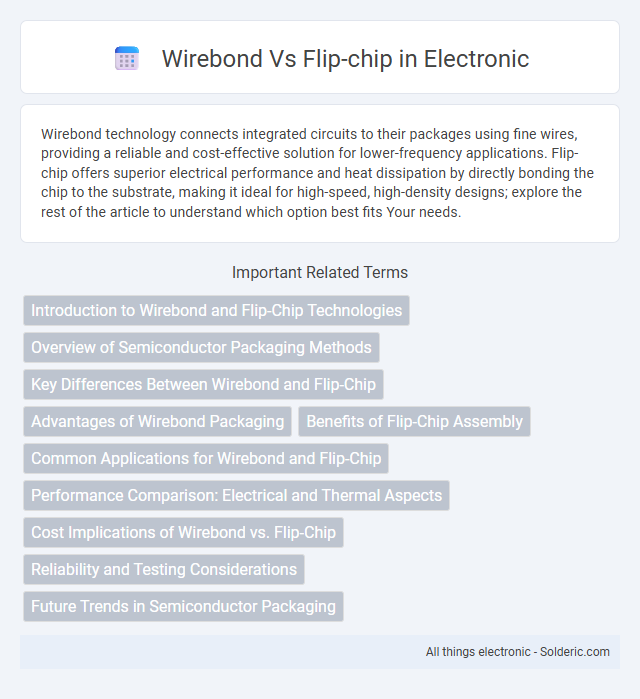Wirebond technology connects integrated circuits to their packages using fine wires, providing a reliable and cost-effective solution for lower-frequency applications. Flip-chip offers superior electrical performance and heat dissipation by directly bonding the chip to the substrate, making it ideal for high-speed, high-density designs; explore the rest of the article to understand which option best fits Your needs.
Comparison Table
| Feature | Wirebond | Flip-chip |
|---|---|---|
| Connection Type | Thin metal wires (usually gold or aluminum) | Direct solder bumps under the chip |
| Signal Performance | Lower frequency, higher inductance | High frequency, low inductance |
| Package Size | Larger due to wire loops | More compact, smaller footprint |
| Thermal Performance | Moderate heat dissipation | Excellent heat dissipation |
| Manufacturing Complexity | Simpler, less expensive | More complex, higher cost |
| Reliability | Susceptible to wire damage | More robust under mechanical stress |
| Applications | Common in low to mid-performance ICs | Used in high-performance, high-density ICs |
Introduction to Wirebond and Flip-Chip Technologies
Wirebond technology utilizes fine metal wires to connect the semiconductor chip to the package or substrate, offering cost-effective and reliable interconnections in microelectronics. Flip-chip technology involves directly attaching the silicon die face-down onto the substrate using solder bumps, enabling higher input/output density and improved electrical performance. Both methods play critical roles in semiconductor packaging, with wirebond favored for its simplicity and flip-chip chosen for advanced, high-speed applications.
Overview of Semiconductor Packaging Methods
Wirebond and flip-chip represent two primary semiconductor packaging methods with distinct advantages and applications. Wirebond technology connects the semiconductor die to the package via fine gold or aluminum wires, offering cost-effectiveness and flexibility for lower-frequency devices. Flip-chip involves directly attaching the die to the substrate using solder bumps, providing superior electrical performance, heat dissipation, and miniaturization for high-frequency and high-power applications.
Key Differences Between Wirebond and Flip-Chip
Wirebond technology uses thin metal wires to connect the semiconductor die to the package, whereas Flip-Chip involves directly mounting the die face-down onto the substrate with solder bumps, enabling shorter electrical paths. Wirebond typically supports lower input/output (I/O) density and is more cost-effective for simpler designs, while Flip-Chip offers superior electrical performance, better thermal dissipation, and higher I/O density suitable for advanced applications. Understanding these key differences helps you select the optimal packaging method based on your device's performance, size, and cost requirements.
Advantages of Wirebond Packaging
Wirebond packaging provides cost-effective manufacturing with simpler processes compared to flip-chip, enabling high-volume production at lower expense. It offers excellent mechanical flexibility and reliable thermal cycling performance, making it suitable for a wide range of semiconductor devices. Wirebond's compatibility with various substrates and ease of repair enhance its versatility for diverse applications in electronics packaging.
Benefits of Flip-Chip Assembly
Flip-chip assembly offers superior electrical performance due to shorter interconnect paths, which significantly reduce parasitic inductance and capacitance. This method enhances thermal management by providing a direct thermal path from the chip to the substrate, improving heat dissipation and reliability. Your designs benefit from higher input/output density, enabling smaller package sizes and better overall device miniaturization compared to traditional wirebond techniques.
Common Applications for Wirebond and Flip-Chip
Wirebond technology is predominantly applied in consumer electronics, automotive sensors, and LED lighting due to its cost-effectiveness and reliability in connecting integrated circuits to package leads. Flip-chip is favored in high-performance computing, smartphones, and advanced imaging devices, offering superior electrical performance and heat dissipation by directly attaching the die to the substrate. Both methods serve critical roles in semiconductor packaging but cater to different requirements based on signal integrity and thermal management.
Performance Comparison: Electrical and Thermal Aspects
Wirebond technology exhibits higher inductance and resistance compared to flip-chip, which can limit signal integrity and speed in high-frequency applications. Flip-chip offers superior electrical performance through shorter interconnect paths and reduced parasitic effects, enhancing signal transmission and power efficiency. Thermal management favors flip-chip mounting due to direct die-to-substrate contact, enabling better heat dissipation and lowering junction temperatures under high-power conditions.
Cost Implications of Wirebond vs. Flip-Chip
Wirebond technology typically incurs lower upfront tooling and packaging costs compared to flip-chip, making it cost-effective for low to medium volume production. Flip-chip, while involving higher initial investment due to complex substrates and underfill materials, offers superior electrical performance and reduced package size, which can lead to cost savings in high-density, high-performance applications. Overall cost implications depend on production scale, application requirements, and performance priorities, with wirebond preferred for simpler, budget-sensitive projects and flip-chip suited for advanced, high-volume semiconductor packaging.
Reliability and Testing Considerations
Wirebond packaging offers proven reliability with established testing protocols that detect defects like wire lift and bond integrity issues, while flip-chip technology provides superior electrical performance but demands rigorous thermal cycling and mechanical stress tests to ensure joint reliability. Flip-chip assemblies undergo meticulous inspections such as X-ray imaging and acoustic microscopy to identify solder bump cracks or voids that could compromise the package. Ensuring your choice aligns with specific reliability targets and testing capabilities is crucial for long-term device performance in complex electronic applications.
Future Trends in Semiconductor Packaging
Future trends in semiconductor packaging emphasize increased adoption of flip-chip technology due to its superior performance in high-frequency applications and enhanced electrical connectivity, supporting the demand for smaller, faster, and more power-efficient devices. Wirebond packaging remains relevant for cost-effective, lower-complexity components, but advanced applications prioritize flip-chip's ability to reduce interconnect lengths and improve thermal dissipation. Industry developments are driving hybrid solutions combining both wirebond and flip-chip methods to optimize performance and cost in next-generation microelectronics.
Wirebond vs Flip-chip Infographic

 solderic.com
solderic.com